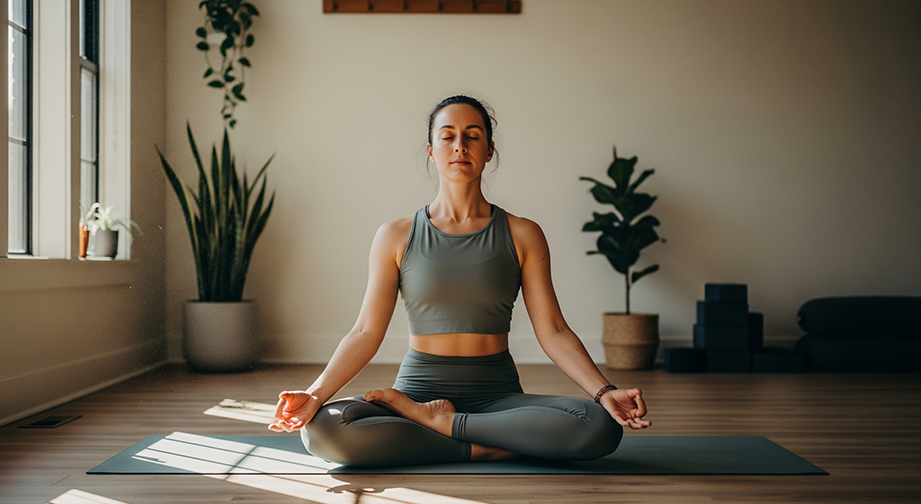Padmasana (Lotus Pose): How to Practice This Classic Yoga Asana
Introduction
Padmasana, commonly known as Lotus Pose, is a classic cross-legged sitting posture in yoga. The Sanskrit word "Padma" means lotus, while "asana" means pose or posture—together symbolizing blooming serenity and peaceful energy.
Essence of Padmasana: Balancing and calming, this pose is loved for its grounding and meditative qualities.
If you've ever felt restless, wobbly, or stiff after a long day, Padmasana can be your best friend. It offers a stable seat for your mind and body, perfect for relaxation or meditation—even if you're a complete beginner.
Step-by-Step Guide to Practice Padmasana

- Start Seated: Sit on your mat with legs stretched out in front and spine straight.
- Bend Right Leg: Gently bend your right knee and bring the right foot up to rest on your left thigh, as close to the hip as possible. The sole faces upward.
- Bend Left Leg: Now, bend your left knee and bring the left foot up to rest on your right thigh. Both feet should have soles facing up and heels close to the abdomen.
- Hands Placement: Rest your hands on your knees. Use a mudra (Chin or Jnana Mudra—thumb and index touching) if comfortable, with palms facing up or down for grounding.
- Find Your Posture: Keep your spine tall, shoulders relaxed, chin parallel to the ground, and gaze softly ahead or gently close your eyes.
- Breathe:
- Inhale slowly, feeling your chest open.
- Exhale and let your knees drop a little closer to the mat.
- Continue slow, steady breaths throughout your time in the pose.
- Duration: Hold Lotus Pose for 1–5 minutes, depending on your comfort. Beginners can aim for 30 seconds and gradually increase.
- Repeat 2–3 rounds, switching the crossing of legs each time.
- To Release: Gently unclasp each leg and stretch both legs out before switching sides.
Modifications for Beginners
- If Lotus is too intense, try Ardha Padmasana (Half Lotus—one foot on opposite thigh, other leg under).
- Sit on a folded blanket or yoga block to lift hips, making it easier to cross your legs comfortably.
Advanced Intensifications
- Fold forward in Lotus for an extra hip stretch.
- Try Utthita Padmasana (Lifted Lotus) by pressing palms into the floor and lifting hips and legs.
Alignment & Safety Tips
- Focus on Hip Opening: Your knees should only bend as much as your hips allow—don’t force them down.
- Knees and Ankles: If you feel any knee or ankle pain, back out of the posture immediately.
- Spine: Keep your spine long, avoid slouching or arching excessively.
- Balance: Weight should be even on both sit bones.
Common Mistakes to Avoid
- Forcing feet onto thighs (can injure knees or ankles)
- Rounding or collapsing the spine
- Lifting shoulders up to ears
- Holding the breath
Safety Precautions
- Avoid Padmasana if you have knee, ankle, or hip injury.
- Do not attempt if pregnant without professional guidance.
- Consult a doctor if you have recent surgery or chronic pain in the lower body.
Benefits of Padmasana (Lotus Pose)
Physical Benefits
- Improves hip and knee flexibility
- Strengthens ankles and lower back
- Supports healthy posture and spinal alignment
- Opens the pelvic region
Mental Benefits
- Calms an anxious mind
- Encourages mindfulness and meditation
- Reduces stress and tension
- Promotes emotional balance
Energy & Chakra Connection
- Balances Muladhara (Root) and Sahasrara (Crown) chakras
- Said to harmonize energy flow throughout the body
Contraindications
- Avoid Padmasana if you have recent knee, hip, or ankle surgery/injury.
- People with severe sciatica or lower back pain should avoid this pose.
- Pregnant women should seek guidance before practice.
Safe Alternatives:
- Easy Pose (Sukhasana)
- Bound Angle Pose (Baddha Konasana)
- Half Lotus (Ardha Padmasana)
Beginner's Tips & Variations
Using Props
- Sit on a folded blanket or cushion to elevate hips
- Rest knees on yoga blocks for support if they don’t touch the floor
- Use a wall behind you for spinal alignment
Gentle Variations
- Try Half Lotus if both feet up is too intense
- Stay in Easy Pose (crossed legs) until ready to advance
Advanced Variations
- Add a forward fold in full Lotus for deep hip opening
- Practice Lotus hand balances if you’re very experienced
How to Include Padmasana in a Yoga Flow
- Best used as a main practice posture for meditation or pranayama, but can also be a grounding pose for warm-up or cool-down.
- Pairs well with: Butterfly Pose (Baddha Konasana), Seated Forward Bend (Paschimottanasana), Cow Face Pose (Gomukhasana).
Mind-Body Connection
As you settle into Lotus Pose, bring awareness to your breath and body. Each inhale lengthens your spine, while each exhale grounds your energy closer to the earth. Traditionally, Padmasana is considered a posture of awakening and enlightenment, symbolizing the unfolding of your inner potential. Working on your Root and Crown chakras, it helps you feel both grounded and elevated.
Asana Name: Padmasana (Lotus Pose)
Level: Intermediate
Focus Areas: Hips, knees, ankles, spine core
Duration: 1–5 minutes (per round)
Best Time to Practice: Morning or evening (avoid after heavy meal)
Frequently Asked Questions about Padmasana (Lotus Pose)
Is Padmasana good for beginners?
Padmasana can be challenging for most beginners, so take it slow and use modifications or props. Don’t force your knees or hips. Try Half Lotus or Easy Pose first and gradually work up to full Lotus.
Why do my knees hurt in Padmasana?
Knee pain in Lotus pose means your hips may not be open enough yet. Never push through joint pain. Practice hip openers and use gentle variations until you’re ready.
How often should I practice Padmasana?
Practice Padmasana a few times a week, gradually increasing duration. Consistency brings flexibility and ease over time!